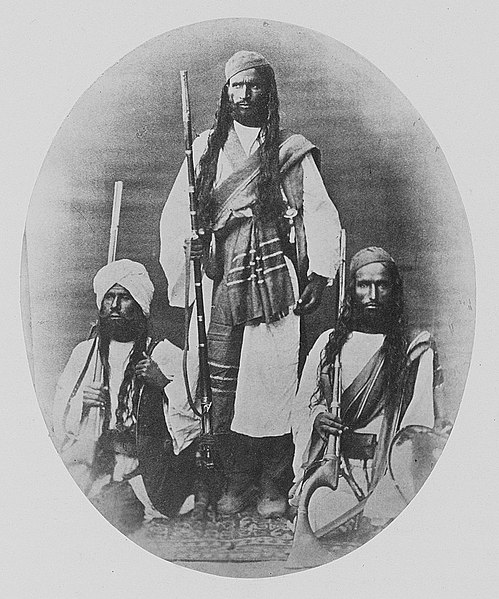
| BRAHVI / BRAHUI
A group of Brahui tribesmen Related ethnic groups : Dravidians
The Brahui, Brahvi or Brohi, are an ethnic group of pastoralists principally found in Balochistan, Pakistan. They primarily speak the Brahui language, which belongs to the Dravidian language family. Many are also bilingual in Balochi and tend to identify as Baloch. The Brahuis are almost entirely Sunni Muslims.
Etymology
:
Location
:
Large numbers of nomadic and semi-nomadic Brahui speakers are also found in Afghanistan, from the Shorawak desert to the northwest of Nushki in Pakistan in an area extending west along the Helmand river into Iranian Sistan. In Iran, no Brahui speakers are found to the south of Sistan, even though G. P. Tate mentioned a few Brahui's in 1909 as far south as Khash who were already assimilating into the neighboring Baloch. Some Brahui are also found in Turkmenistan, mainly in the Merv oasis. Most of these Turkmenistani Brahuis are descendants of the Brahui who migrated together with the Baloch from British administered Balochistan and Afghanistan in the late 19th and early 20th centuries.
Population
:
Origins
:
The history of the Brahui emerges from total darkness with the displacement of a shadowy Hindu dynasty in Kalat called Sewa by the Mirwani Brahuis.
— Murray Barnson Emeneau, Language and Linguistic Area: page 334
A Brahui Sardar (chieftain) among his men, in the valley of Kalat Tribes
:
Currently, the so-called Brahui nation comprises 27 tribes, of which 8 are referred to as nuclear tribes, and 19 are peripheral. Significant majority of Brahuis is related to peripheral tribes. Representatives of only two nuclear tribes speak Brahui as a primary language. The "nucleus" consists of the Achmadzai, Gurguari, Iltazai, Kalandari, Kambrani, Mirwari, Rodeni and the Sumalari, but they account for only a small proportion of the total number of Brahuis. The majority is divided up between the Jhalawan Brahuis (which include the tribes of the Bizanjars, Harunis, Muhammad Hasnis, Mengals, Nicharis, Pandranis, Sajdis and the Zahris), and the Sarawan Brahuis (comprising the tribes of the Bangulzai, Kurd, Lahri, Langav, Muhammad-Shahi, Raisani, Rustamzai, Sarparah, Satakzai, Shahwani and Zagar-Mengal).
Language
and literacy :
The Brahui language belongs to the Dravidian language family, while Balochi is an Iranian language. Brahui has extensively borrowed from Balochi and other languages of the area (Indo-Aryan as well as Iranian); McAlpin (2015) found the language to be an "etymological nightmare". Brahui has three dialects with no significant variation among them: Sarawani (spoken in the north), Jhalawani (spoken in the southeast), and Chaghi (spoken in the northwest and west). It does not have any standard script and there does not appear to exist any significant corpus of literature either; literacy rates among Brahuis remained very low as late as 1990s.
Source :
https://en.wikipedia.org/ |

_in_the_valley_of_Kalat,_anonymous,_c._1866_-_in_or_before_1876.jpg)